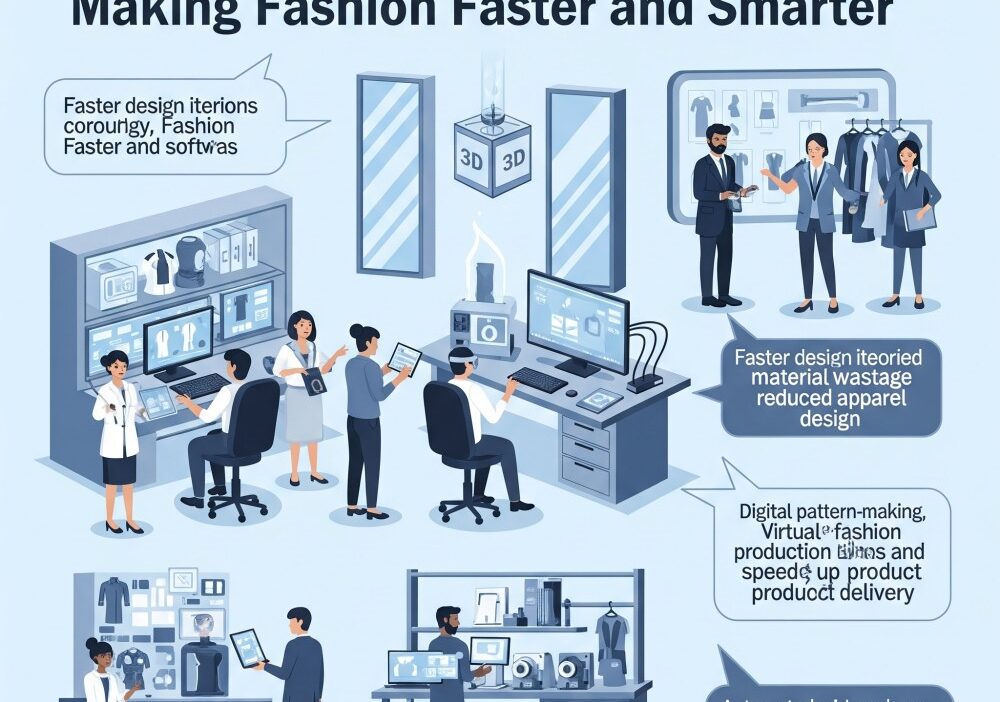In today’s fast-moving world, fashion is not just about creativity — it’s also about speed, precision, and smart processes. Fashion designing technology is playing a big role in changing how clothes are imagined, designed, and made. With the rise of digital tools, software, and smart machines, both students and professionals are able to create fashion faster and smarter than ever before.
This blog will explore how this technology is shaping the future of fashion and how learners can benefit from it, especially those exploring fashion design short term courses or different fields of fashion design.
Digital Sketching Speeds Up the Design Process
Earlier, designers spent hours drawing, erasing, and redrawing on paper. Now, digital sketching software allows designers to create, edit, and share their ideas instantly. Programs like Adobe Illustrator, CorelDRAW, and Procreate help save time and make changes quickly. Students learning digital tools during fashion design short term courses gain a big advantage when entering the industry.
3D Modelling Makes Prototyping Smarter
One of the most exciting parts of fashion designing technology is 3D modeling. Tools like CLO 3D and Marvelous Designer let you create virtual garments that look and move like real clothes. This means designers can see how a dress fits or flows without actually sewing it. It also helps them spot mistakes before producing physical samples, saving time and fabric.
CAD Tools Improve Accuracy in Pattern Making
Computer-Aided Design (CAD) tools are now widely used to draft accurate patterns. In the past, this process involved a lot of manual effort, but now software makes it easier to repeat designs, store templates, and change sizes with a few clicks. This reduces errors and speeds up production, especially in large collections.
Tech Supports Sustainable Design
One of the growing concerns in all fields of fashion design is sustainability. Fashion designing technology helps here too. Digital sampling means fewer fabric wastes. AI tools can predict demand and reduce overproduction. Technologies like laser cutting reduce fabric loss and save energy. These changes are helping the fashion world become more environmentally responsible.
Fashion Shows are Now Virtual
Another area where fashion has become faster and smarter is how it is presented. Virtual fashion shows and 3D model showcases are now common. Using animation and AR (Augmented Reality), designers can show off their collections to a global audience without physically shipping clothes or gathering large crowds. This is especially helpful for new designers trying to gain exposure without high budgets.
Smart Textiles are Changing the Game
Tech isn’t just in the software—it’s also in the fabrics. Smart textiles can change color with temperature, track heart rate, or even light up. These innovations are bringing fashion closer to technology in a way that was never possible before. Designers working in special fields of fashion design like wearable tech are using these materials to create clothing that does more than just look good.
AI Tools Help Predict Trends
AI (Artificial Intelligence) is another part of fashion designing technology that helps designers stay ahead. It can analyze huge amounts of data to predict upcoming trends, popular colors, and buying patterns. This helps brands design what people actually want to wear, reducing waste and improving sales.
Learning Technology Through Fashion Design Short Term Courses
Many students want to enter fashion quickly without committing to a full degree. Fashion design short term courses now include training in digital tools, 3D software, and CAD systems. These courses are perfect for students who want to build a smart portfolio, apply for internships, or start freelancing in fashion.
Some courses also offer introductions to AR, AI, and sustainable fashion technologies. This early exposure helps students feel confident in both traditional and modern design approaches.
Conclusion: A Smarter Future for Fashion
Fashion designing technology is not replacing creativity — it is enhancing it. Whether you want to work in styling, garment production, virtual fashion, or sustainability, tech is involved in some way. It is improving speed, accuracy, and decision-making across all fields of fashion design.
Learning this technology does not require a full degree. Even with fashion design short term courses, students can gain real experience and useful skills. The future of fashion is not just stylish — it’s smart. And those who understand the tech behind the beauty will lead the industry forward.



